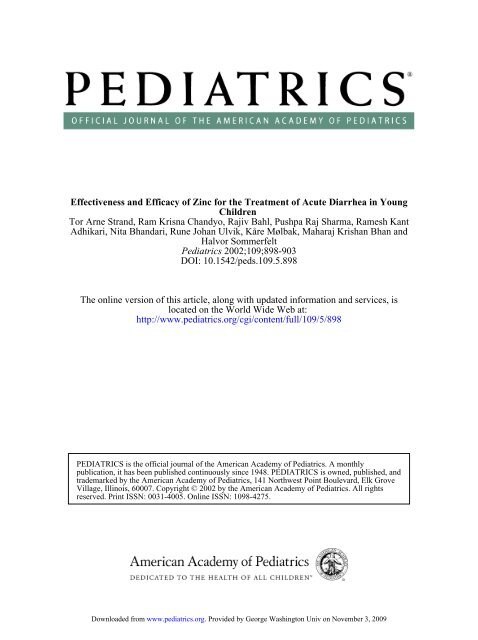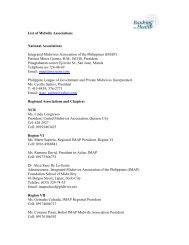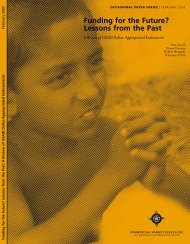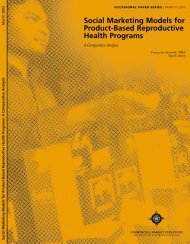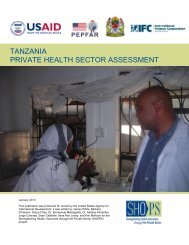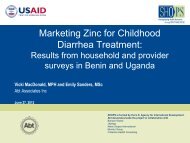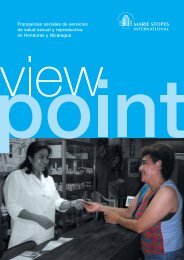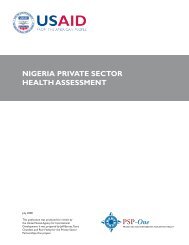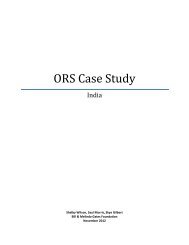DOI: 10.1542/peds.109.5.898 2002;109;898-903 Pediatrics Halvor ...
DOI: 10.1542/peds.109.5.898 2002;109;898-903 Pediatrics Halvor ...
DOI: 10.1542/peds.109.5.898 2002;109;898-903 Pediatrics Halvor ...
Create successful ePaper yourself
Turn your PDF publications into a flip-book with our unique Google optimized e-Paper software.
Effectiveness and Efficacy of Zinc for the Treatment of Acute Diarrhea in YoungChildrenTor Arne Strand, Ram Krisna Chandyo, Rajiv Bahl, Pushpa Raj Sharma, Ramesh KantAdhikari, Nita Bhandari, Rune Johan Ulvik, Kåre Mølbak, Maharaj Krishan Bhan and<strong>Halvor</strong> Sommerfelt<strong>Pediatrics</strong> <strong>2002</strong>;<strong>109</strong>;<strong>898</strong>-<strong>903</strong><strong>DOI</strong>: <strong>10.1542</strong>/<strong>peds.<strong>109</strong>.5.<strong>898</strong></strong>The online version of this article, along with updated information and services, islocated on the World Wide Web at:http://www.pediatrics.org/cgi/content/full/<strong>109</strong>/5/<strong>898</strong>PEDIATRICS is the official journal of the American Academy of <strong>Pediatrics</strong>. A monthlypublication, it has been published continuously since 1948. PEDIATRICS is owned, published, andtrademarked by the American Academy of <strong>Pediatrics</strong>, 141 Northwest Point Boulevard, Elk GroveVillage, Illinois, 60007. Copyright © <strong>2002</strong> by the American Academy of <strong>Pediatrics</strong>. All rightsreserved. Print ISSN: 0031-4005. Online ISSN: <strong>109</strong>8-4275.Downloaded from www.pediatrics.org. Provided by George Washington Univ on November 3, 2009
Effectiveness and Efficacy of Zinc for the Treatment ofAcute Diarrhea in Young ChildrenTor Arne Strand, MD*‡; Ram Krisna Chandyo, MD*‡; Rajiv Bahl, MD, PhD§;Pushpa Raj Sharma, MBBS, DCH, FCPS‡; Ramesh Kant Adhikari, MD‡; Nita Bhandari, PhD§;Rune Johan Ulvik, MD, PhD; Kåre Mølbak, MD, PhD; Maharaj Krishan Bhan, MD§; and<strong>Halvor</strong> Sommerfelt, MD, PhD*ABSTRACT. Intervention trials have shown that zinc isefficacious in treating acute diarrhea in children of developingcountries. In a randomized, placebo-controlledtrial, we assessed the effectiveness and efficacy of giving3 Recommended Daily Allowances of elemental zinc to6- to 35-month-old children with acute diarrhea.Methods. Seventeen hundred ninety-two cases ofacute diarrhea in Nepalese children were randomized to4 study groups. Three groups were blinded and the childrensupplemented daily by field workers with placebosyrup, zinc syrup, or zinc syrup and a massive dose ofvitamin A at enrollment. The fourth group was open andthe caretaker gave the children zinc syrup daily. Daywiseinformation on morbidity was obtained by householdvisits every fifth day.Results. The relative hazards for termination of diarrheawere 26% (95% confidence interval [CI]: 8%, 46%),21% (95% CI: 4%, 38%), and 19% (95% CI: 2%, 40%)higher in the zinc, zinc-vitamin A, and zinc-caretakergroups, respectively, than in the placebo group. The relativerisks of prolonged diarrhea (duration >7 days) inthese groups were 0.57 (95% CI: 0.38, 0.86), 0.53 (95% CI:0.35, 0.81), and 0.55 (0.37, 0.84); zinc accordingly reducedthe risk of prolonged diarrhea with 43% to 47%. Fivepercent and 5.1% of all syrup administrations were followedby regurgitation in the zinc and zinc-vitamin Agroup, respectively, whereas this occurred after only 1.3%of placebo administrations. Vomiting during diarrheawas also more common in children receiving zinc.Conclusions. Three Recommended Daily Allowancesof zinc given daily by caretakers or by field workerssubstantially reduced the duration of diarrhea. The effectof zinc was not dependent on or enhanced by concomitantvitamin A administration. <strong>Pediatrics</strong> <strong>2002</strong>;<strong>109</strong>:<strong>898</strong>–<strong>903</strong>; zinc, vitamin A, acute diarrhea, young children, randomizedplacebo controlled trial, effectiveness, Nepal,treatment.ABBREVIATIONS. RDA, Recommended Daily Allowance.From the *Center for International Heath, University of Bergen, Bergen,Norway; ‡Department of Child Health, Tribhuvan University, Kathmandu,Nepal; §Department Paediatrics, All India Institute of Medical Sciences,New Delhi, India; Department of Epidemiology Research, Statens SerumInstitut, Copenhagen, Denmark; and Institute of Clinical Biochemistry,University of Bergen, Norway.Received for publication Sep 11, 2001; accepted Jan 2, <strong>2002</strong>.Address correspondence to <strong>Halvor</strong> Sommerfelt, MD, PhD, Center for InternationalHealth, University of Bergen, Armauer Hansen Building, N-5021Bergen, Norway. E-mail: halvor.sommerfelt@cih.uib.noPEDIATRICS (ISSN 0031 4005). Copyright © <strong>2002</strong> by the American Academyof <strong>Pediatrics</strong>.Intervention trials indicate that zinc given duringacute diarrhea is efficacious in reducing the durationand severity of the illness. 1–7 Thus, therapeuticuse of zinc has the potential of reducing theannual 2.5 million childhood diarrheal deaths. 8 Arecent pooled analysis showed a small beneficial effectof zinc given by health personnel on the risk ofcontinuation of diarrhea. The overall reduction in therisk of prolonged diarrhea, defined as an episodelasting 7 days, was 20% and had a wide confidenceinterval that included 1. 6 The effectiveness ofzinc when given by caretakers has yet to be determined.Zinc is involved in the release of vitamin A fromthe liver cells, 9 in the synthesis of retinol-bindingprotein, 10 and the effect of zinc in infectious diseasesmay be dependent on adequate vitamin A status. 10,11In some of the trials that showed a beneficial impactof zinc during diarrhea, the participants in the placeboas well as in the zinc group were given vitaminA or a micronutrient mixture that included vitaminA. 1–3,6,7 It is possible that, in some of these trials,the replenishment of vitamin A stores were a prerequisitefor the effects of zinc. A recent study fromBangladesh indicated that zinc and vitamin A supplementationinteracted in reducing the prevalenceof persistent diarrhea and dysentery in children. 12However, other studies from Bangladesh failed todemonstrate an interaction between these 2 micronutrientsgiven during diarrhea. 5,13The effectiveness of zinc administration should beappropriately investigated before it is recommendedroutinely as an adjunct therapy for acute childhooddiarrhea in developing countries. Moreover, an indepthevaluation of possible adverse effects of zincadministration is needed and has been lacking inreports from previous trials.In a placebo-controlled trial, we administered 3Recommended Daily Allowances (RDAs) 14 of elementalzinc, which is in the upper range of the dosesgiven in previous trials. We chose a relatively largedose because zinc is lost in the stool during diarrhea,15 and because of the variable effect of zinc inprevious studies. 1–7 The supplement was given dailyby field workers or by caretakers to assess efficacyand effectiveness, respectively, of zinc on the durationof acute childhood diarrhea, on the proportionof episodes that became prolonged, and on stool<strong>898</strong> PEDIATRICS Vol. <strong>109</strong> No. 5 May <strong>2002</strong>Downloaded from www.pediatrics.org. Provided by George Washington Univ on November 3, 2009
frequency. We also monitored the children for adverseeffects. Furthermore, we included a studygroup to ensure that the effect of zinc was not restrictedto children that were simultaneously supplementedwith vitamin A.METHODSThis was a double-blind, randomized, placebo-controlled trialin children designed to measure the impact of daily zinc administrationwith or without a massive vitamin A dose at enrollmenton the duration and severity of acute diarrhea. The effectiveness ofthe caretaker giving zinc to the child was assessed in an opengroup whereas the 3 other study groups (placebo, zinc, and vitaminA-zinc) were double-blinded (Fig 1).The trial had ethical clearance from the Nepalese and Norwegiannational health authorities. The implementation of all aspectsof the project was in agreement with the International EthicalGuidelines for Research Involving Human Subjects as stated in thelatest version of the Helsinki Declaration. Informed and, whenpossible, written consent was obtained from at least 1 of theparents.Sample Size CalculationsThe sample sizes were calculated for 80% power and 95%confidence. In the calculations we assumed that 20% of the casesin the placebo group had a duration of 7 days 1 and set thedesired percentage of such prolonged episodes in each of theintervention groups to 12.5 (ie, 37.5% reduction), which resulted ina required group size of 405. With an expected 10% loss to followup,we decided to enroll 450 episodes in each of the 4 studygroups. The power to detect any superadditive effect of zinc andvitamin A over zinc alone was lower; this comparison was not anobjective of the trial.Inclusion and Exclusion Criteria, Definitions, andRandomizationWe enrolled children from the whole municipality of Bhaktapur,which is the third largest town in the Kathmandu valley inNepal. Children were recruited by weekly household-based surveillanceand at spontaneous visits to the study field clinic. Diarrheawas defined as the passage of 3 or more loose or watery stoolsin the 24-hour period before enrollment. Eligible children werescreened in the clinic by a physician and included if the responsiblecaretaker was willing to let him/her participate. We includedchildren between 6 and 35 months that had had diarrhea for 96hours. Children were allocated to either of the 4 interventiongroups (Fig 1) by simple randomization with blocks of 16.A child was not included if he or she had received a massivedose of vitamin A during the previous 4 weeks, had severe illnessrequiring hospitalization, or if the family intended to leave Bhaktapurwithin 2 months. We allowed a child to be rerandomizedand enrolled in the study only if 4 months had lapsed fromrecovery from the previous enrollment episode.Recovery from diarrhea was defined as the first of the first 2consecutive diarrhea-free days. A diarrhea-free day was a daywhen the child passed 3 loose and no watery stools.Interventions, Blinding, and CointerventionsVitamin A or placebo administered from identical capsuleswere given on the enrollment day, and zinc or placebo syrup weregiven daily during diarrhea until 7 days after recovery. The placebosyrup (1 kg syrup contained 597 g of water, 400 g of sugar,1.2 g of peach flavor number 061508 [Einar Willumsen, 23–25Abildager, Brøndby, Denmark], 1gofmethylparabene, 1gofxanthan gum, 0.15 g of saccharin sodium) and the zinc syrup wereidentical in appearance. The taste and acceptability of the syrupwas assessed in Scandinavian and Indian adults and childrenbefore manufacture. The highest concentration at which the tasteof the placebo and zinc syrups was identical was 2.5 mg of zinc permL, although even additional dilution could not mask a minormetallic aftertaste. We administered 6 and 12 mL of syrup daily toinfants and older children, respectively, to provide 3 RDAs of zinc.The capsules and syrup with backups were packed in separateplastic bags, which were assigned a unique serial number before itwas shipped to Nepal. The randomization list that linked the serialnumbers with the group identity was kept at the Statens SerumInstitute in Copenhagen, Denmark, until the end of enrollmentand follow-up. Whether the child belonged to the open “caretakerzinc”group or to one of the blinded placebo, zinc, or zinc-vitaminA groups was not revealed to the study staff until after the childhad been enrolled. This information was kept inside sealed envelopesin the individual plastic bags that were opened only after thevitamin A or placebo capsules were administered. In the placebo,zinc, and zinc-vitamin A groups, the syrup was administereddaily by a field worker at home except on public holidays whenthe syrup was given by the caretaker, usually the mother. In thecaretaker-zinc group, the caretakers were requested to administerthe zinc syrup every day. Thus, the study staff and the caretakersin the open “caretaker-zinc” group knew that the children receivedzinc.Oral rehydration salts packets were given to the mother withinstructions on its mixing and administration, along with standardmessages on feeding. Acute lower respiratory tract infections,dysentery, anemia, and severe malnutrition were managed accordingto World Health Organization guidelines. 16Fig 1. Profile of a randomized, placebo-controlledtrial evaluating 3 RDAsof daily zinc administration as treatmentfor acute diarrhea in children 6 to35 months of age.ARTICLES 899Downloaded from www.pediatrics.org. Provided by George Washington Univ on November 3, 2009
Data CollectionChildren were weighed at enrollment using a scale with 100 gsensitivity (Salter, SECA, Germany). A study physician drewblood from the cubital vein into zinc-free heparinized polypropylenetubes (Sarstedt, Nümbrecht, Germany) at enrollment andin a 15% random subsample after 14 days. Heparinized blood wascentrifuged, separated, and transferred to zinc-free polypropylenevials (Eppendorf, Hinz, Germany) and kept frozen until analysis.The hemoglobin concentration was analyzed with Hemocue (Ängelholm,Sweden), and cases of anemia were treated with ironsulfate according to national guidelines. Plasma zinc was determinedby inductively coupled plasma atomic emission spectrometryfrom Thermo (Jarell-Ash, Franklin, MA), at a wavelength of206.2 nm.We examined the child and recorded day-wise information onmorbidity every fifth day until recovery from the diarrhea episode.At each visit, details of illness characteristics, including thenumber and character of stools and vomiting, on each day sincethe last visit were obtained, and hydration status was assessed.Compliance was measured by reported intake and by measuringthe remaining volume of syrup in the returned bottles. On agroup level, delivery of zinc was assessed by average change inplasma zinc concentration from baseline. Field workers observedand recorded side effects such as regurgitation of the syrup duringthe first 15 minutes after administration. In the caretaker-zincgroup, information on compliance, regurgitation, and vomitingwas based on recall and recorded every fifth day on the morbidityvisit. In addition, on the last day of supplementation when childrenwere visited for bottle collection, the response to an openquestion about other side effects was recorded.The field workers were trained until they reached the desiredlevel of intra-observation and interobservation variability for measurementof respiratory rate, body temperature, height, andweight. They were also trained to memorize the standard messagesto ensure uniformity of the information to the study participants.Retraining, standardization, and supervision of the fieldstaff were done at 5 monthly intervals throughout the data collectionperiod. Throughout the entire study period, in 8% of all homevisits, supervisors or study physicians supervised the field workersor undertook independent visits, completing the same questionnairesin addition to a separate form on field worker performance.This was done to ensure appropriate interaction betweenthe participants and the study staff and to maximize data quality.Data Management and AnalysisThe data were double entered into Microsoft VisualFoxProdatabases (Microsoft Corp, Redmond, WA) with computerizedlogic, range, and consistency checks. If errors were detected, theforms were returned to the field for correction the next day.Weight-for-age, length-for-age, and weight-for-length z scoreswere calculated using LMS values 17 obtained from Centers forDisease Control and Prevention growth charts. 18 Statistical analyseswere undertaken using the statistical, data managementpackage Stata, version 6 (StataCorp, College Station, TX) and SASversion 8.1 (SAS Institute, Cary, NC). All analyses were conductedon an intent-to-treat basis. The identity of the 4 interventiongroups was revealed to the investigators only after the statisticalanalyses were completed. Log-transformed counts of the totalnumber of stools during the first 4 days were compared betweenthe groups using linear regression, values were antilogged, andthe results were expressed as geometric mean or the ratios ofgeometric means compared with the placebo group.Relative risks were obtained by a generalized linear model withbinomial variability and a logarithmic link function. Comparisonof the number of days from enrollment until recovery was undertakenusing a Cox proportional hazards model with the “discrete”option in SAS for handling ties. We coded the outcomes andinterventions so that ratios of geometric mean 1, relative risks1, and hazard ratios 1 would represent a beneficial effect.Correction for repeated entries of the same child was done bygeneralized estimation equations with an exchangeable covariance-variancestructure corresponding to a random cluster effect.RESULTSTwenty-nine percent of the enrolled children werestunted and 22% wasted (Table 1). Infants constituted41% and there were more boys (55%) than girls.The residence of the children was evenly distributedamong the 17 administrative areas of Bhaktapur municipality.One hundred eighty-five children wereenrolled twice, and 13 were enrolled 3 times.Almost 10% reported blood in stools before enrollmentand, when examined by the study physician,12% were mildly dehydrated. We had few dropouts,which were evenly distributed among the studygroups (Fig 1). Of the 14 children lost before recovery,5 withdrew consent, and 9 migrated out of thestudy area.Baseline characteristics, including the severity ofdisease, pre-enrollment duration, child and familycharacteristics, and baseline zinc concentrations wereevenly distributed between the intervention groups(Table 1). More than 95% of the scheduled doseswere reported to be consumed in all 4 groups; thiswas confirmed by measuring the remaining syrup onreturn of the bottles and reflected in the change inplasma zinc concentration (Table 2).The mean duration of diarrhea was shorter and theproportion with duration more than 3, 7, and 14 daysconsistently and substantially lower among the chil-TABLE 1. Enrollment Characteristics of 4 Groups of Children 6 to 35 Months of Age in a Trial Evaluating 3 RDAs of Daily ZincAdministration as Treatment for Acute DiarrheaVariableStudy GroupPlacebo Zinc Vitamin A-Zinc Caretaker-ZincMean age, mo 15.9 (7.9) 15.3 (7.6) 15.5 (7.8) 15.4 (7.9)Percentage of infants 39.2 39.8 39.6 43.8Percentage male gender 54.6 58.8 54.4 53.6Percentage breastfed 81.4 82.8 83.6 83.7Total number of stools 24 h before enrollment 8.8 (4.1) 9.0 (4.2) 9.2 (4.5) 8.8 (3.5)Number of watery stools 24 h before enrollment 3.1 (4.1) 3.0 (4.0) 3.2 (4.2) 2.6 (3.8)Percentage reporting blood in stool 12.1 10.7 8.4 7.8Mean number of diarrhea days before enrollment 2.2 (1.2) 2.1 (1.2) 2.2 (1.1) 2.2 (1.1)Percentage dehydrated 11.9 12.1 10.4 12.1Percentage less than 2Z length for age (stunted) 29.5 29.1 31.3 27.9Percentage less than 2Z weight for length (wasted) 23.3 21.5 23.8 20.3Mean hemoglobin level (g/dL) 11.2 (1.1) 11.1 (1.1) 11.1 (1.3) 11.1 (1.3)Percentage of mothers who can read 50.0 53.1 45.6 58.1Percentage of fathers who can read 83.8 88.4 81.0 86.5Average plasma zinc concentration (mol/dL) 8.6 (1.4) 8.7 (2.2) 8.8 (1.5) 8.7 (1.9)Standard deviation in parentheses; dehydration defined according to World Health Organization guidelines.900 EFFECTIVENESS OF ZINC IN ACUTE CHILDHOOD DIARRHEADownloaded from www.pediatrics.org. Provided by George Washington Univ on November 3, 2009
TABLE 2. Main Outcomes in a Trial Evaluating 3 RDAs of Daily Zinc Administration as Treatment for Acute Diarrhea in Children6 to 35 Months of AgeVariableStudy GroupPlacebo Zinc Vitamin A-Zinc Caretaker-ZincDuration of supplementation (d) 10.6 9.9 10.0 10.0Percent of days with scheduled syrup98.2 97.6 97.1 95.8administrationAverage daily zinc ingested by the infants 0 1.9 1.9 1.9(mg/kg/d)Average daily zinc ingested by other children 0 3.1 3.1 3.1(mg/kg/d)Mean plasma zinc (mol/dL) change (SD)* 0.2 (2.1) 3.7 (5.9) 4.6 (8.0) 2.7 (4.7)Mean plasma copper (mol/dL) change (SD)* 1.5 (4.2) 1.1 (5.5) 1.4 (4.1) 1.8 (4.5)Relative hazard (time to recovery) 1 1.26 (1.08,1.46) 1.21 (1.04,1.38) 1.19 (1.02,1.40)Risk Ratios or Ratios of Geometric MeanCompared With Placebo (95% CI)Cases (%) with postenrollment duration 3 d 159 (35.7) 0.75 (0.61,0.91) 0.83 (0.68,1.00) 0.80 (0.66,0.97)Cases (%) with postenrollment duration 7 d 58 (13.1) 0.57 (0.38,0.86) 0.53 (0.35,0.81) 0.55 (0.37,0.84)Cases (%) with postenrollment duration 14 d 11 (2.5) 0.55 (0.20,1.47) 0.64 (0.25,1.63) 0.64 (0.25,1.63)Cases (%) with postenrollment watery diarrhea 167 (37.6) 0.91 (0.76,1.08) 0.90 (0.76,1.08) 1.03 (0.87,1.21)Geometric mean number of stools first 4 d(95% CI)13.9 (13.2,14.6) 0.91 (0.85,0.97) 0.95 (0.89,1.02) 0.93 (0.87,1.00)SD indicates standard deviation; CI, confidence interval.* Change from enrollment until 14 days thereafter.dren in the zinc, vitamin A-zinc, and caretaker zincgroups than in the placebo group (Table 2). Thehazard ratios between the placebo group and theintervention groups were 1.26, 1.21, and 1.19, respectively.The proportion with prolonged diarrhea was43%, 47%, and 45% lower in these 3 groups (Table 2)compared with placebo. Only 2.5% of the episodes inthe placebo group lasted 14 days after enrollment.The effect sizes at this cutoff were similar to whatwas seen at day 7, but with wider confidence intervals,which included 1 (Table 2).Daily average stool frequency during the first 4days after enrollment was marginally lower in childrenthat received zinc (Table 2). The proportion ofcases with watery diarrhea after enrollment in thechildren receiving zinc was not substantially or significantlydifferent from those receiving placebo (Table2).There was no difference among the 3 groups ofchildren that received zinc in the severity, as measuredby stool frequency, or in the duration of diarrhea(Table 2).Other EffectsA higher proportion of syrup administrations wasfollowed by regurgitation in the children receivingzinc than in those receiving placebo (Table 3). In theplacebo group, 1.3% of the administrations were followedby regurgitation while this percentage was5.0%, 5.1%, and 7.3% in the zinc, vitamin A-zinc, andcaretaker zinc groups, respectively. The figures inTable 3 give the percentage with regurgitation on thefirst day and on the subsequent days separately.Approximately one third of these regurgitations occurredon the enrollment day regardless of groupidentity. The excess regurgitation in children givenzinc was similar in the different age groups (Table 3).The total vomiting beyond the 15 minutes after syrupadministration was also higher in the children receivingzinc (Table 3).An open question asked on the last day of supplementationrevealed no other side effects than vomitingor regurgitation, nor were any such adverseevents observed during the intervention period. Thechange in plasma copper was the same in childrenreceiving zinc as in children receiving placebo (Table2).Eight hundred thirty-two of the enrolled childrenmade 1209 visits to the field clinic; the number ofvisits and the number of children who visited thefield clinic were similar among the interventiongroups. Likewise, there were no differences in caretaker-reportedmorbidity, the number of physicianvisits, or hospitalizations during the 1-month periodafter recovery from the diarrhea episode.DISCUSSIONOur data show a substantial and highly significantbeneficial effect of zinc on the duration of diarrhea inchildren between 6 and 35 months of age. We enrolledchildren from an entire Nepalese urban area,and the recruitment was not restricted to a slum or toselected patient groups. This is in contrast to previousreports where inclusions were limited to lowersocioeconomic strata, hospitalized, or to malnourishedchildren. 1–7 The overall effect size in thepresent study was larger than what has previouslybeen reported. Thus, in our study, zinc resulted in a43% to 47% reduction in the risk of prolonged diarrhea.This impact is similar to what was found in thesubgroup of children enrolled by day 3 after onset ofdiarrhea in a trial in a New Delhi slum. 1 We includedonly children who had had diarrhea for 4 days orless, suggesting that zinc is more effective whengiven early in the course of the illness.Although we demonstrated a reduction in dailytotal stool frequencies, this effect was of muchsmaller magnitude than that on duration. The mostimportant effect of zinc is probably to prevent anutritional insult caused by persistence of the epi-ARTICLES 901Downloaded from www.pediatrics.org. Provided by George Washington Univ on November 3, 2009
TABLE 3. Regurgitation of Syrup and Vomiting Among Children 6 to 35 Months of Age in a Trial Evaluating 3 RDAs of Daily ZincAdministration as Treatment for Acute DiarrheaVariableStudy GroupPlacebo Zinc VitaminA-ZincCaretaker-ZincPercentage of children with syrup regurgitation 6.1* 18.6* 21.0* 24.4on enrollment dayRisk ratios (95% CI) 1 3.1 (2.0,4.7) 3.6 (2.4,5.4) 4.0 (2.7,6.0)Infants 4.6 16.9 20.9 23.6Risk ratios (95% CI) 1 3.7 (1.7,7.8) 4.6 (2.2,9.5) 5.2 (2.5,10.6)Older than 12 mo 7.0 19.7 21.1 25.1Risk ratios (95% CI) 1 2.8 (1.7,4.6) 3.0 (1.8,4.9) 3.6 (2.2,5.8)Percentage of days with syrup regurgitation0.9* 3.8* 3.8* 5.8after inclusion dayRisk ratios (95% CI) 1 4.3 (2.8,6.6) 4.0 (3.1,5.1) 5.6 (4.4,7.2)Infants 1.0 3.9 4.1 6.2Risk ratios (95% CI) 1 3.9 (2.5,6.1) 4.0 (2.6,6.34) 6.1 (4.0,9.4)Older than 12 mo 0.8 3.7 3.6 5.5Risk ratios (95% CI) 1 4.4 (2.9,6.7) 4.3 (2.8,6.5) 6.6 (4.4,9.9)Percentage of children with reported vomiting 18.9 32.7 37.1 38.8on enrollment dayRisk ratios (95% CI) 1 1.7 (1.4,2.2) 2.0 (1.6,2.5) 2.1 (1.6,2.6)Percentage of days during diarrhea with8.7 16.0 17.3 17.9vomiting after enrollment dayRisk ratios (95% CI) 1 1.8 (1.42,2.45) 2.0 (1.6,2.6) 2.0 (1.5,2.6)CI indicates confidence interval.* Children were observed for regurgitation and other adverse effects for 15 minutes after a field worker had given the zinc or the placebosyrup.sode and not to reduce the risk of severe dehydration,19 and should therefore be considered as an importantaddition to oral rehydration therapy.This trial demonstrates that zinc is as effective intreating diarrhea when given daily by the caretakeras when given by trained field workers. In our population,the effect was not restricted to children whowere also given vitamin A, nor was it enhanced byvitamin A administration at enrollment, although thepower to identify the latter was limited. This indicatesthat zinc exerts its beneficial effect independentlyof vitamin A. Indeed, the results from studiesof the effect of vitamin A on the recovery from acutediarrhea are conflicting. 11,20–22The compliance in the caretaker zinc (effectiveness)group may have been reinforced by the morbidityvisits. However, the field workers were requestedto restrain from message delivery duringthese visits and the effectiveness of zinc was evidentalready on the third day after enrollment (Table 2),ie, even before the first morbidity visit.Zinc-supplemented children experienced more regurgitationand vomiting than did children who receivedplacebo. Regurgitation and vomiting have notpreviously been reported as a side effect of zincwhen treating diarrhea. Our findings may be attributableto the fact that our dose was relatively highcompared with many other trials, and that in some ofthese trials, the daily dose was divided. 3,4,7 On theother hand, it could also be a reflection of morecareful monitoring, as adverse effects were one of thestudy outcomes. One third of the regurgitation aftersyrup ingestion occurred on the first day. In additionto the fact that the children may have been somewhatstressed in the field clinic, a more careful dispensingby the field workers or caretakers or gastrointestinaladaptation to zinc may explain the lower regurgitationfrequency on the subsequent days. The observedregurgitation and vomiting did apparently not interferewith the oral rehydration therapy, nor was zincsupplementation associated with dehydration (datanot shown). If zinc is to be used routinely in acutediarrhea, adjustment or division of the daily dose, orperhaps mixing zinc with the oral rehydration saltssolution, could increase acceptance and thereby securea high effectiveness under program conditions.Other trials suggest that a lower daily zinc dose maybe almost as efficacious 1,3,5 with seemingly no excessvomiting or regurgitation, although the registrationof side effects may have been less rigorous than inour study. Therefore, a daily dose of 2 RDAs may beadvisable. Copper status may be affected by zincadministration 15 ; plasma copper levels were not influencedby the short term therapeutic zinc administrationof our study.We were not able to demonstrate any differencesin morbidity among the study groups during the1-month follow-up period after recovery. Thus, anybeneficial effect of zinc supplementation beyond theepisode was not identified, nor did we reveal anyincreased morbidity in the children who receivedzinc.No other treatment has been proven as efficaciousas zinc in reducing the duration of acute diarrhea inchildren of developing countries. Antibiotics, antiparasitic,antimotility, and antisecretory drugs andgastric enzymes are overused. Zinc is efficaciousand, in this trial, despite some increase in regurgitationand vomiting, effective and safe in the treatmentof diarrhea. If promoted as an integral part of theroutine management of acute diarrhea instead of theabove mentioned inefficacious and potentially harmfulremedies, the promotion of oral rehydration therapymay be strengthened and the spread of antibiotic902 EFFECTIVENESS OF ZINC IN ACUTE CHILDHOOD DIARRHEADownloaded from www.pediatrics.org. Provided by George Washington Univ on November 3, 2009
esistance limited. A substantial proportion of diarrhealdeaths occur in prolonged diarrhea. 19,23 Decreasingthe occurrence of prolonged and persistentdiarrhea by zinc administration may substantiallyreduce the number of childhood diarrhea deaths.ACKNOWLEDGMENTSThis study was supported by EU-INCO-DC contract numberIC18-CT96–0045 and NUFU project number PRO 52–53/96.We are grateful for the contribution of Dr Hemang Dixit, DrFakir Chandra Gami, and Dr Manjeshwori Ulak. We thank thestaff and the founder, Shyam Dhoubadel, of Siddhi MemorialHospital in Bhaktapur for their cooperation, and the families andchildren who participated in the study. Finally, we thank MichaelHambidge, Jamie Westcott, and Nancy Krebs, University of ColoradoHealth Sciences Center, Denver, Colorado, for quality controlof the plasma zinc analyses.REFERENCES1. Sazawal S, Black RE, Bhan MK, Bhandari N, Sinha A, Jalla S. Zincsupplementation in young children with acute diarrhea in India [seecomments]. N Engl J Med. 1995;333:839–8442. Sachdev HP, Mittal NK, Mittal SK, Yadav HS. A controlled trial onutility of oral zinc supplementation in acute dehydrating diarrhea ininfants. J Pediatr Gastroenterol Nutr. 1988;7:877–8813. Roy SK, Tomkins AM, Akramuzzaman SM, et al. Randomised controlledtrial of zinc supplementation in malnourished Bangladeshi childrenwith acute diarrhoea. Arch Dis Child. 1997;77:196–2004. Hidayat A, Achadi A, Sunoto, Soedarmo SP. The effect of zinc supplementationin children under three years of age with diarrhea in Indonesia.Med J Indonesia. 1998;7:237–2415. Faruque AS, Mahalanabis D, Haque SS, Fuchs GJ, Habte D. Doubleblind,randomized, controlled trial of zinc or vitamin A supplementationin young children with acute diarrhoea. Acta Paediatr. 1999;88:154–1606. Bhutta ZA, Bird SM, Black RE, et al. Therapeutic effects of oral zinc inacute and persistent diarrhea in children in developing countries:pooled analysis of randomized controlled trials. Am J Clin Nutr. 2000;72:1516–15227. Dutta P, Mitra U, Datta A, et al. Impact of zinc supplementation inmalnourished children with acute watery diarrhoea. J Trop Pediatr.2000;46:259–2638. Murray CJ, Lopez AD. Alternative projections of mortality and disabilityby cause 1990–2020. Global Burden of Disease Study [see comments].Lancet. 1997;349:1498–5049. Boron B, Hupert J, Barch DH, et al. Effect of zinc deficiency on hepaticenzymes regulating vitamin A status. J Nutr. 1988;118:995–100110. Christian P, West KP Jr. Interactions between zinc and vitamin A: anupdate. Am J Clin Nutr. 1998;68(2 suppl):435S–441S11. Bhan MK, Bhandari N. The role of zinc and vitamin A in persistentdiarrhea among infants and young children. J Pediatr Gastroenterol Nutr.1998;26:446–45312. Rahman MM, Vermund SH, Wahed MA, Fuchs GJ, Baqui AH, AlvarezJO. Simultaneous zinc and vitamin A supplementation in Bangladeshichildren: randomised double blind controlled trial. BMJ. 2001;323:314–31813. Khatun UH, Malek MA, Black RE, et al. A randomized controlledclinical trial of zinc, vitamin A or both in undernourished children withpersistent diarrhea in Bangladesh. Acta Paediatr. 2001;90:376–38014. Recommended Daily Allowances. 10th ed. Washington, DC: NationalAcademy of Sciences, National Academy Press; 198915. Walsh CT, Sandstead HH, Prasad AS, Newberne PM, Fraker PJ. Zinc:health effects and research priorities for the 1990s. Environ Health Perspect.1994;2:5–4616. World Health Organization DoCH. Integrated Management of ChildhoodIllness. Geneva, Switzerland: World Health Organization; 1997. ReportNo. WHO/CDH/97.3E17. Cole TJ. The LMS method for constructing normalized growth standards.Eur J Clin Nutr. 1990;44:45–6018. Kuczmarski RJ, Ogden CL, Grummer-Strawn LM, et al. CDC growthcharts: United States. Adv Data. 2000;314:1–2719. Black RE. Persistent diarrhea in children of developing countries. PediatrInfect Dis J. 1993;12:751–761. Discussion 762–76420. Henning B, Stewart K, Zaman K, Alam AN, Brown KH, Black RE. Lackof therapeutic efficacy of vitamin A for non-cholera, watery diarrhoea inBangladeshi children. Eur J Clin Nutr. 1992;46:437–44321. Sempertegui F, Estrella B, Camaniero V, et al. The beneficial effects ofweekly low-dose vitamin A supplementation on acute lower respiratoryinfections and diarrhea in Ecuadorian children. <strong>Pediatrics</strong>. 1999;104(1).Available at: http://www.pediatrics.org/cgi/content/full/104/e122. Dibley MJ, Sadjimin T, Kjolhede CL, Moulton LH. Vitamin A supplementationfails to reduce incidence of acute respiratory illness anddiarrhea in preschool-age Indonesian children. J Nutr. 1996;126:434–44223. Bhandari N, Bhan MK, Sazawal S. Mortality associated with acutewatery diarrhea, dysentery and persistent diarrhea in rural north India.Acta Paediatr Suppl. 1992;381:3–6CELL PHONES AND WAR IN THE CONGO“Few owners on mobile phones realize that their technical gadgets may linkthem to one of the deadliest of contemporary wars—the conflict in the DemocraticRepublic of Congo. COLTAN, short for Columbite-Tantalite, is one of the rawmaterials that warring factions have battled over . . . Tantalum is crucial for themanufacture of capacitors, tiny components that regulate the flow of current oncircuit boards. As one journalist put it, ‘for the high-tech industry, tantalum ismagic dust.’”Vick K. Vital ore funds Congo’s war. Washington Post. March 19, 2001Submitted by StudentARTICLES <strong>903</strong>Downloaded from www.pediatrics.org. Provided by George Washington Univ on November 3, 2009
Effectiveness and Efficacy of Zinc for the Treatment of Acute Diarrhea in YoungChildrenTor Arne Strand, Ram Krisna Chandyo, Rajiv Bahl, Pushpa Raj Sharma, Ramesh KantAdhikari, Nita Bhandari, Rune Johan Ulvik, Kåre Mølbak, Maharaj Krishan Bhan and<strong>Halvor</strong> Sommerfelt<strong>Pediatrics</strong> <strong>2002</strong>;<strong>109</strong>;<strong>898</strong>-<strong>903</strong><strong>DOI</strong>: <strong>10.1542</strong>/<strong>peds.<strong>109</strong>.5.<strong>898</strong></strong>Updated Information& ServicesReferencesCitationsSubspecialty CollectionsPermissions & LicensingReprintsincluding high-resolution figures, can be found at:http://www.pediatrics.org/cgi/content/full/<strong>109</strong>/5/<strong>898</strong>This article cites 17 articles, 6 of which you can access for freeat:http://www.pediatrics.org/cgi/content/full/<strong>109</strong>/5/<strong>898</strong>#BIBLThis article has been cited by 10 HighWire-hosted articles:http://www.pediatrics.org/cgi/content/full/<strong>109</strong>/5/<strong>898</strong>#otherarticlesThis article, along with others on similar topics, appears in thefollowing collection(s):Gastrointestinal Tracthttp://www.pediatrics.org/cgi/collection/gastrointestinal_tractInformation about reproducing this article in parts (figures,tables) or in its entirety can be found online at:http://www.pediatrics.org/misc/Permissions.shtmlInformation about ordering reprints can be found online:http://www.pediatrics.org/misc/reprints.shtmlDownloaded from www.pediatrics.org. Provided by George Washington Univ on November 3, 2009


